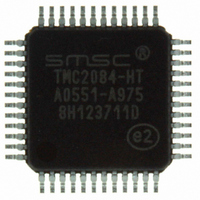TMC2084-HT SMSC, TMC2084-HT Datasheet - Page 13

TMC2084-HT
Manufacturer Part Number
TMC2084-HT
Description
IC CTRLR CIRCLINK TM 48-TQFP
Manufacturer
SMSC
Series
CircLink™r
Datasheet
1.TMC2084-HT.pdf
(74 pages)
Specifications of TMC2084-HT
Controller Type
I/O Controller
Interface
Transceiver
Voltage - Supply
3 V ~ 3.6 V
Operating Temperature
0°C ~ 70°C
Mounting Type
Surface Mount
Package / Case
48-TQFP, 48-VQFP
Lead Free Status / RoHS Status
Lead free / RoHS Compliant
Current - Supply
-
Other names
638-1025
Available stocks
Company
Part Number
Manufacturer
Quantity
Price
Company:
Part Number:
TMC2084-HT
Manufacturer:
Intel
Quantity:
128
Company:
Part Number:
TMC2084-HT
Manufacturer:
Microchip Technology
Quantity:
10 000
Standalone Mode CircLink
Datasheet
Chapter 2
2.1
2.1.1
SMSC TMC2084
Network Configuration
General
Host Node and I/O Node
A CircLink network can consist of a single host node/multi I/O node, or multiple host nodes/single I/O, or
multiple host nodes and multiple I/O nodes. The host node is directly connected to the system (external)
CPU, which controls all communications to or from it. The device that can be used for the host node should
be a TMC2072/74 that is configured to operate in Peripheral mode; the TMC2084 is dedicated for the use
as an I/O node only (Standalone mode). The I/O nodes do not require the CPU and they are controlled
indirectly via the network by the CPU through the host node.
The CircLink network allows a combination of host nodes and I/O nodes up to 15 nodes total. Every
CircLink network must have at least one host node.
The host node controls the following I/O node functions:
These functions are controlled through the network.
Section 2.1.2 shows two examples: network configuration example 1 (single host) that includes one host
node and fourteen I/O nodes, and network configuration example 2 (dual host) that includes two host
nodes and four I/O nodes. When multiple hosts are used, I/O nodes should be grouped so that each host
can control its corresponding group as shown in network configuration example 2: Host 1 controls both I/O-
1 and -2; Host 2 controls both I/O-3 and -4.
Node ID
Any node that belongs to a network should have a unique identification number (ID). The ID is configured
using shared pins NID3 - 0. When shared pin PSSL is set to L, the allowable range of the node ID is 1
trough 7; it is 1 through 15 when the PSSL pin is set to H. 0 is not allowed for any node ID.
Consecutive node ID numbers (beginning with 1) are assigned to nodes in a network. Consecutive node ID
numbers should be used, because each unused ID number between 2 working node IDs causes a latency
of 93.6 μs (2.5 Mbps operation) every time a token is sent and thus degrades overall network performance.
Input and output activities on a port (sending and receiving data and initializing the port)
Setting various configuration data
Request for configuration data
Activation of transmission activity
Software reset
TM
Controller
Functional Description
DATASHEET
Page 13
Revision 0.2 (10-23-08)













